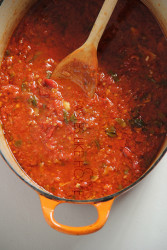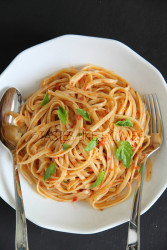Hi Everyone,
Are you interested in a sauce that you can make in large batches that stores well; a sauce that can be used all year round for a variety of dishes – meat and meatless – and even serve as dip? Got tomatoes? Make Marinara.

If you usually buy jarred sauces for pasta, pizza, casseroles, or dipping, then you should seriously consider saving yourself a whole lot of money by making your own Marinara, an Italian tomato-based sauce. You will not only be saving money but your taste buds will thank you, as your version will be far superior to any jar that you have popped the lid.
Apart from tomatoes selling for as little as Barbados 75-cents to 2-dollars, and me doing my usual stocking up, I have been binge-watching The Sopranos on HBO on-demand, and suddenly had a craving for Italian food. In its simplest form, for me, it means a comforting bowl of pasta tossed with homemade tomato sauce.

There are many variations of Marinara that can include spices, capers, anchovies and even wine but I prefer the classic version that calls for only 6 ingredients – oil, garlic, tomatoes, red pepper flakes, salt and basil. Thyme, bay leaves and oregano can be switched out with the basil to still keep the sauce classic. While I prefer the classic version, I often ‘doctor’ it with additions such as assertively fresh rosemary, sweeten it with caramelized onions, concentrate it with chicken stock, fire-roast the tomatoes for a charred and smoky flavour or heat things up with a scotch bonnet or two. On occasion, I’ve even added freshly toasted and ground cumin (jeera).

The uses of Marinara are many – apart from the usual tossing/dressing of pasta and forming the base of pizza, the sauce can be added to soups, stews, casseroles and pies. It can be used as a dip for a variety of snacks and appetizers. You can top seafood to be grilled or steamed with Marinara sauce. Ladle it over poached, scrambled or sunny-side up eggs or baked potatoes. Another great idea is to bake eggs in the sauce; this can be done in individual ramekins or nested in a pan. Mix Marinara into meatloaf and top the meatloaf with the sauce. Spoon it over cornmeal Cou-cou; stir it into the cheese sauce for macaroni pie; use it to make Mexican (Spanish) Rice. Instead of making curried eggs, ‘stew’ the eggs cooking them in the Marinara sauce after boiling (and frying). Stir a little bit into baigan choka or eat it with hot, soft, sada roti for a satisfying meal.
When tomatoes are in seasonal abundance, it is the opportune time to make Marinara sauce; make large batches to store. To store the sauce, you don’t have to fuss about canning, simply arm yourself with some quart-size freezer bags. Because the sauce is more of a thick liquid, it takes up little space when placed flat and frozen, once frozen you can leave the stack lying flat or turn them upright depending on how much room you have in your freezer.
Most recipes call or 1, 2, or 3 cups of the sauce. I would suggest that you store in the capacity that you know you are most likely to use the sauce based on the size of your family. Or, portion the sauce depending on the types of dishes you most often make and the quantity required. Be sure to label the bags so you know the quantity in each bag. If you know that you are likely to be using the sauce regularly (at least twice a week), keep the sauce in sterilized glass jars with tight fitting lids in the refrigerator. If your recipe does not require you to use the entire jar, use a clean, dry utensil to remove the quantity needed.
Classic Marinara Sauce (with some additions)
INGREDIENTS
- ½ cup vegetable or Canola oil (see notes section)
- 12 cloves garlic, peeled and sliced thinly
- ½ teaspoon red pepper flakes (see notes section)
- 1 teaspoon minced fresh oregano or ½ teaspoon
dried oregano
- 1 teaspoon minced fresh thyme
- 1 small bay leaf (fresh or dried)
- 3 pounds ripe, firm tomatoes, washed, pat dry and
chopped
- 1 cup tap water
- 1 ½ teaspoons fine table salt
- 3 large sprigs fresh basil
DIRECTIONS
Add the oil to a large skillet or deep frying pan and place over medium heat until hot.
Add garlic and cook for 30 seconds only (do not let it brown), add the pepper flakes, oregano, thyme, and bay leaf. Cook for 30 seconds.
Add the tomatoes, water, and salt, stir to mix and let pot come to a boil. Add the sprigs of basil to the pot and push them to submerge in the sauce. Let cook for 10 minutes; reduce heat to slow and simmer for 20 minutes. (All cooking should be done with the pan/pot uncovered)
Mash the softened tomatoes with a potato masher and then let sauce continue to simmer for 15 minutes or until it has thickened. Taste for salt and add more if needed.
Let sauce cool completely before storing.
NOTES
- If you have Olive oil, you can use it to make the sauce but I find that it really does not make a difference to the overall taste of the sauce, especially given the length of cooking time required for the sauce.
- I use my homemade red pepper flakes but minced fresh hot pepper can be used instead or even pepper sauce. Add pepper to suit your taste.
- If you do not have access to oregano, use 2 teaspoons of minced Guyanese fine thyme instead of 1 teaspoon.
- Remove the stems of the basil before storing the sauce.
- Defrost and bring sauce to room temperature before using.
Marinara can be made using canned whole tomatoes but the idea in this column is for the use of seasonal ingredients in abundance.
Cynthia



